When it comes to choosing a high-end TV, you may have heard of QNED and OLED technologies.
While both offer impressive picture quality, they differ in the way they achieve it.
QNED combines quantum dot and NanoCell technology, while OLED utilizes self-emitting pixels.
In this article, we’ll discuss QNED Vs OLED and help you determine which one is best for your viewing needs.
QNED Vs OLED: Comparison
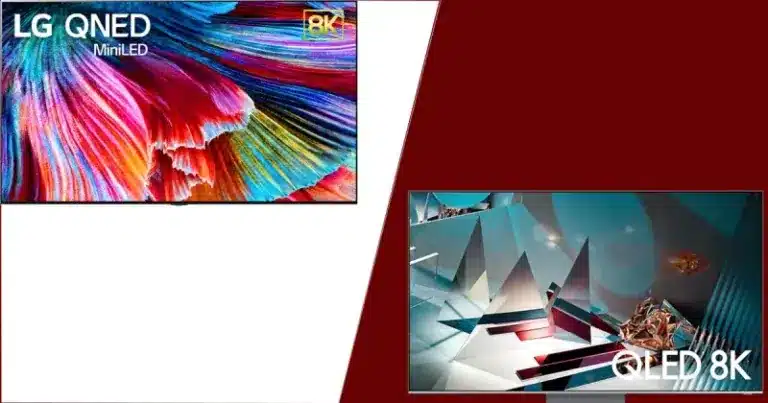
| Feature | QNED | OLED |
| Display Technology | QNED uses Quantum Dot technology with LED backlighting. | OLED uses organic compounds that emit light when an electric current is applied. |
| Black Levels | QNED may have deep black levels, but it depends on the quality of local dimming. | OLED has true black levels as each pixel emits its own light and can be turned off individually. |
| Contrast Ratio | High contrast ratio due to the potential for deep blacks and bright whites. | Excellent contrast ratio because of true blacks and bright whites. |
| Color Accuracy | Good color accuracy, enhanced by Quantum Dot technology. | Exceptional color accuracy and vibrancy, as each pixel produces its own light. |
| Viewing Angles | Generally good viewing angles, but may not be as wide as OLED. | OLED offers wide viewing angles with consistent color and brightness. |
| Response Time | QNED typically has fast response times, suitable for gaming and fast-paced content. | OLED has fast response times, making it suitable for gaming and sports. |
| Brightness | Can achieve high levels of brightness, but it depends on the specific model. | OLED TVs are not as bright as some QLED models, but they offer sufficient brightness for most viewing conditions. |
| Lifespan | QNED’s lifespan is influenced by the LED backlighting and may be longer than OLED. | OLED has a finite lifespan as the organic compounds may degrade over time, but it’s generally long enough for typical use. |
| Thickness | Generally thicker than OLED TVs due to the use of LED backlighting. | OLED TVs are thin and can be flexible, allowing for innovative designs. |
| Cost | QNED TVs may be more cost-effective than OLED, depending on the model and features. | OLED TVs are often more expensive due to the manufacturing process and technology. |
QNED Vs OLED: Pros & Cons
| Aspect | QNED | OLED |
| Pros | ||
| Display Technology | Uses Quantum Dot technology for enhanced color accuracy. | Individual pixel lighting results in true blacks and vibrant colors. |
| Black Levels | Can achieve deep blacks, depending on the quality of local dimming. | Offers true black levels due to the ability to turn off individual pixels. |
| Contrast Ratio | High contrast ratio, thanks to potential deep blacks and bright whites. | Excellent contrast ratio for vivid and lifelike images. |
| Response Time | Generally fast response times, suitable for gaming and fast-paced content. | Fast response times make it suitable for gaming and sports. |
| Viewing Angles | Good viewing angles, though not as wide as OLED. | Wide viewing angles with consistent color and brightness. |
| Brightness | Can achieve high brightness levels, depending on the specific model. | Bright enough for most viewing conditions, though not as bright as some QLED models. |
| Lifespan | Lifespan may be longer than OLED due to LED backlighting. | Finite lifespan due to potential degradation of organic compounds over time. |
| Thickness | Typically thicker than OLED TVs. | Thin and flexible, allowing for sleek and innovative designs. |
| Cons | ||
| Black Levels | May not achieve true blacks in every scenario, depending on local dimming. | Risk of temporary or permanent image retention (burn-in). |
| Viewing Angles | Viewing angles may not be as wide as OLED, with potential color shift. | Limited color accuracy and brightness at extreme viewing angles. |
| Cost | Generally more cost-effective than OLED, but prices may vary. | Often more expensive due to the manufacturing process and technology. |
| Lifespan | LED backlighting may degrade over time, affecting overall lifespan. | Limited lifespan due to potential degradation of organic compounds. |
| Summary | QNED offers a balance of performance and cost, suitable for various needs. | OLED provides unparalleled picture quality but may come at a higher cost and with some risk of burn-in. |
QNED Vs OLED: Technology Overview
When it comes to high-end TV technology, two of the most popular options are Quantum Nano Emitting Diode (QNED) and Organic Light-Emitting Diode (OLED).
Both offer impressive picture quality, but they use different methods to achieve it.
Quantum Nano Emitting Diode (QNED) Basics
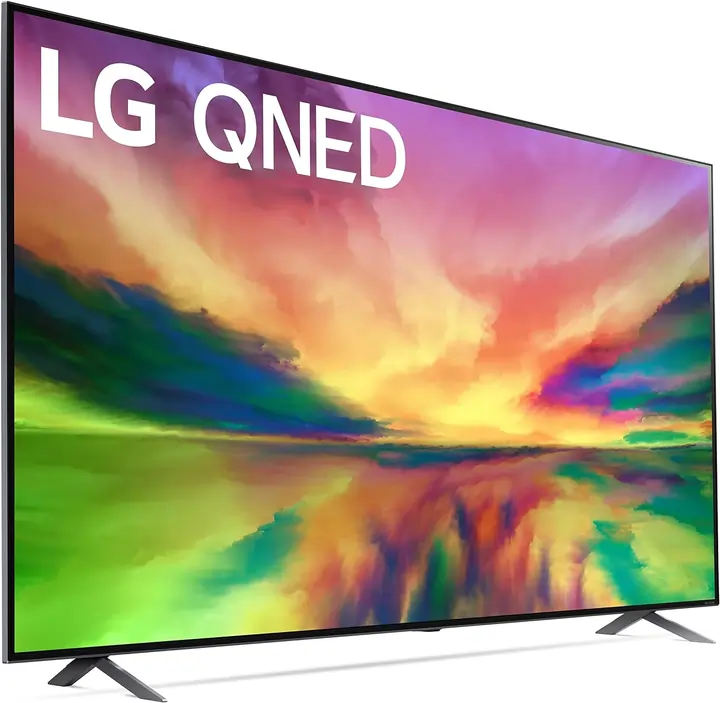
QNED is a relatively new technology that combines Quantum Dot and NanoCell technologies.
Quantum Dots are tiny particles that emit light when exposed to electricity.
NanoCell technology uses tiny particles to filter out unwanted light wavelengths, resulting in more accurate colors and improved contrast.
Quantum Nano Emitting Diode TVs use a backlight to illuminate the screen, but the Quantum Dots and NanoCells help to enhance the brightness and color accuracy.
They also have a high number of dimming zones, which can help to improve contrast.
Organic Light-Emitting Diode (OLED) Basics
OLED is a well-established technology that has been used in TVs for several years.
Instead of using a backlight, each pixel on an OLED TV emits its light.
This allows for true blacks and infinite contrast, as the pixels can be turned off completely when displaying black.
Organic Light Emitting Diode TVs are known for their excellent color accuracy and viewing angles.
They also have a fast response time, which makes them ideal for watching sports or playing video games.
QNED Vs OLED: Design and Form Factor
When it comes to design and form factor, both QNED and OLED TVs have their unique advantages and disadvantages.
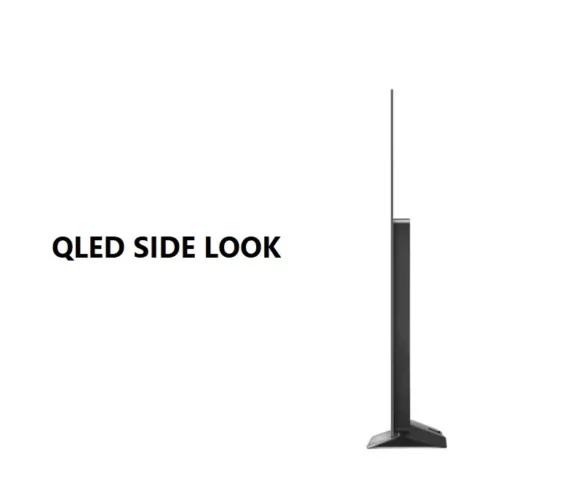
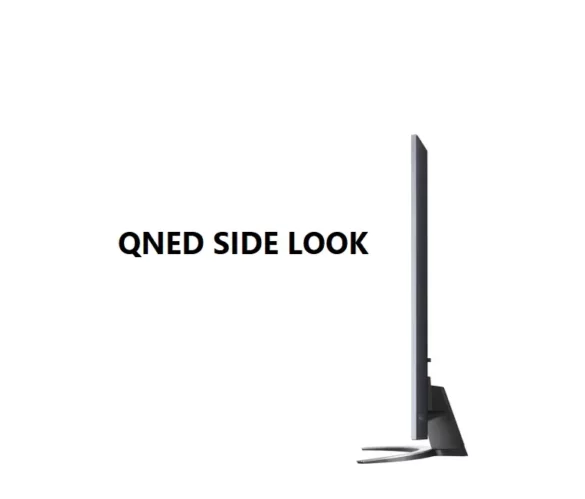
QNED Vs OLED: Panel Thickness
In terms of panel thickness, QNED TVs are thinner than OLED TVs. The thickness of a QNED TV is around 1 inch, while an OLED TV is around 1.93 inches.
This difference in thickness may not be significant, but it can make a difference if you are looking for a TV that is as slim as possible.
QNED Vs OLED: Flexibility and Curvature
When it comes to flexibility and curvature, OLED TVs have an advantage over QNED TVs.
OLED panels are flexible, which means they can be bent or curved to fit different shapes and sizes.
This flexibility allows manufacturers to create unique and innovative designs that are not possible with QNED panels.
On the other hand, QNED panels are not flexible and cannot be curved.
They are more durable than OLED panels and less prone to screen burn-in.
QNED panels are made with a special material called “nano-color” that is more resistant to degradation than the organic materials used in OLED panels.
Read Also: OSRS AHK Meaning in RuneScape Automation
QNED Vs OLED: Image Quality Comparison
Color Accuracy
OLED displays are known for their excellent color accuracy, thanks to their self-emitting pixels.
This means that each pixel can turn on and off independently, resulting in vibrant and accurate colors.
QNED displays use quantum dots and NanoCell technology to enhance color accuracy.
While they may not be as accurate as OLED displays, they still offer a wide color gamut and excellent color reproduction.
Brightness and Contrast
When it comes to brightness and contrast, OLED displays are the clear winner.
Since each pixel can turn on and off independently, OLED displays can achieve perfect blacks and infinite contrast.
This means that dark scenes in movies and TV shows will look more realistic and immersive. QNED displays, on the other hand, use backlighting to achieve brightness.
While they can still get very bright, they may not be able to achieve the same level of contrast as OLED displays.
Viewing Angles
Both QNED vs OLED displays offer excellent viewing angles but for different reasons.
OLED displays maintain color accuracy and contrast at wider angles, making them ideal for group viewing.
QNED displays, on the other hand, use Nano Cell technology to maintain color accuracy and contrast even when viewed from off-center positions.
This means that you can still enjoy vibrant and captivating visuals even if you’re not sitting directly in front of the screen.
QNED Vs OLED: Durability and Lifespan
When it comes to investing in a high-end TV, durability and lifespan are important factors to consider.
QNED Vs OLED: Burn-In Potential
Burn-in refers to the permanent damage that can occur to a TV screen when a static image is displayed for an extended period. OLED TVs are known to have a higher risk of burn-in compared to QNED TVs.
This is because OLED pixels emit their own light, and over time, the pixels can degrade unevenly, resulting in burn-in.
On the other hand, QNED TVs use quantum dot technology, which is not susceptible to burn-in.
The quantum dots are used to produce the backlight, and since they do not emit their light, there is no risk of burn-in.
Read Also: Anker Soundcore Review: Yay or Nay?
QNED Vs OLED: Lifespan Expectancy
The lifespan of a TV is determined by the longevity of its components. OLED TVs have a shorter lifespan compared to QNED TVs.
OLED pixels degrade over time, which can lead to a loss of brightness and color accuracy. This means that an OLED TV may need to be replaced sooner than a QNED TV.
QNED TVs have a longer lifespan due to their use of quantum dot technology.
Quantum dots are known for their stability and long lifespan, which means that QNED TVs can last for several years without any significant degradation in picture quality.
QNED Vs OLED: Energy Efficiency and Consumption

When it comes to energy efficiency and consumption, OLED TVs are known to be more energy efficient than QNED TVs.
This is because OLED TVs use self-illuminating pixels that do not require a backlight, which results in lower energy consumption.
QNED TVs use mini-LED backlights, which consume more energy.
To give you an idea of the difference in energy consumption between the two, a 55-inch OLED TV consumes around 150 watts of power, while a 55-inch QNED TV consumes around 200 watts of power.
This means that OLED TVs can save you money on your electricity bill in the long run.
Another factor to consider is the energy efficiency rating. OLED TVs are generally rated higher in energy efficiency than QNED TVs.
For example, the LG OLED C1 has an energy efficiency rating of A, while the LG QNED 90 has an energy efficiency rating of B.
QNED Vs OLED: Cost Implications
Production Costs
The production costs of QNED and OLED TVs differ significantly.
QNED TVs use quantum dot nanocrystals and mini-LED backlighting technology, which are cheaper to produce than OLED panels.
OLED panels are more complex to manufacture and require more expensive materials, such as organic compounds and rare earth elements.
QNED Vs OLED: Retail Pricing
OLED TVs were quite expensive due to the complexity of their manufacturing process.
Technology has matured and production methods have improved, prices have gradually decreased.
OLED TVs and displays are now more accessible to a broader range of consumers.
On the other hand, QNED TVs are relatively new to the market, and their pricing is still relatively high.
As production methods improve and technology becomes more widespread, prices are expected to decrease.
It’s worth noting that the retail pricing of both QNED and OLED TVs varies significantly depending on the brand, screen size, and features.
For example, LG’s OLED TVs are generally more expensive than other brands, while Hisense’s QNED TVs are more affordable.
Use Cases and Applications
When it comes to choosing between QNED and OLED, it’s important to consider the use cases and applications that you have in mind.
Both technologies have unique strengths that make them suitable for different scenarios.
QNED
QNED technology is relatively new, and its use cases are still being explored.
It offers several advantages over traditional LCD displays. QNED displays have a higher brightness level, which makes them ideal for use in brightly lit environments.
They also have a wider color gamut, which means that they can display a broader range of colors than traditional LCD displays.
One of the most promising use cases for QNED technology is in the field of gaming.
QNED displays have a faster response time than traditional LCDs, which means that they can keep up with fast-paced games without any lag or ghosting.
QNED displays also have a high refresh rate, which makes them ideal for displaying fast-moving images.
OLED
OLED technology has been around for longer than QNED, and its use cases are well-established. OLED displays offer several advantages over traditional LCD displays.
They have a higher contrast ratio, which means that they can display deeper blacks and brighter whites than traditional LCDs.
They also have a wider viewing angle, which means that you can see the display clearly from almost any angle.
One of the most popular use cases for OLED displays is in the field of home entertainment.
OLED displays are ideal for watching movies and TV shows because they can display deep blacks and bright colors.
They are also ideal for gaming because they have a fast response time and a high refresh rate.
Frequently Asked Questions about QNED Vs OLED
What are the main differences in picture quality between QNED vs OLED televisions?
The main difference in picture quality between QNED and OLED televisions is the way they produce light.
OLED TVs use organic compounds that emit light when an electric current is passed through them.
This means that each pixel can turn on and off independently, resulting in perfect blacks and infinite contrast.
On the other hand, QNED TVs use a combination of quantum dots and mini-LED backlights to produce light.
While they can produce more colors than OLEDs, they cannot achieve the same level of contrast and black levels.
Which technology offers better gaming performance, QNED vs OLED?
Both QNED and OLED displays offer excellent gaming performance, but OLEDs have a slight edge.
OLEDs have faster response times than QNED displays, which means that they can display fast-moving images with less motion blur.
OLEDs have perfect blacks, which can enhance the contrast and immersion in dark games.
QNED displays have higher brightness levels, which can make them a better choice for bright rooms.
What advantages do QNED TVs have over traditional LED or Mini LED TVs?
QNED TVs have several advantages over traditional LED or Mini LED TVs.
First, they can produce more colors than traditional LEDs, which can result in more accurate and lifelike images.
Second, they have better contrast than traditional LEDs, which can enhance the overall picture quality.
Finally, they are more energy-efficient than traditional LEDs, which can save you money on your electricity bill.

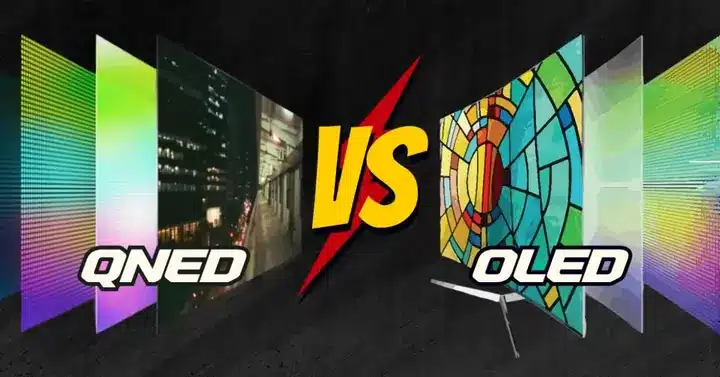
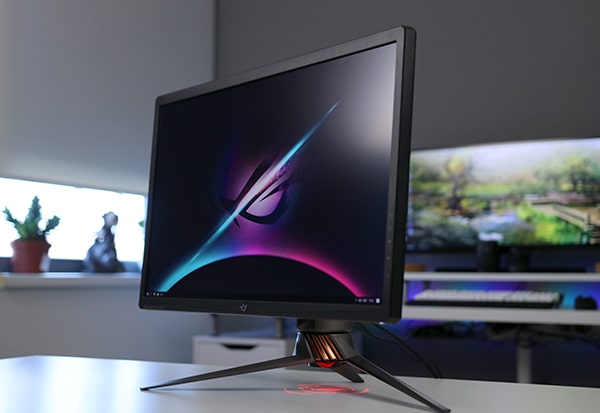



Cool website.